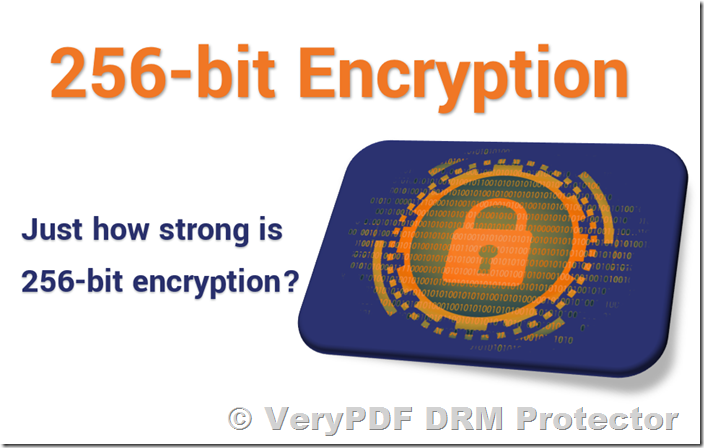In an era where data breaches and cyber threats are rampant, safeguarding sensitive information is no longer optional—it’s essential. One of the most robust tools in the cybersecurity arsenal is AES 256-bit encryption, a gold standard for protecting digital assets. In this article, we’ll explore what AES 256-bit encryption is, why it matters, and how VeryPDF DRM Protector leverages this technology to secure your documents.
What Is AES 256-Bit Encryption?
AES (Advanced Encryption Standard) is a symmetric encryption algorithm established by the U.S. National Institute of Standards and Technology (NIST) in 2001. The “256-bit” refers to the length of the encryption key, which is virtually unbreakable with current computing power. Here’s why it stands out:
-
Military-Grade Security: AES 256 is trusted by governments, financial institutions, and cybersecurity experts worldwide.
-
Symmetric Encryption: The same key encrypts and decrypts data, ensuring speed without compromising security.
-
Resilience Against Attacks: With 2²⁵⁶ possible key combinations, brute-force attacks would take billions of years to succeed.
Why AES 256-Bit Encryption Matters for Your Business
-
Data Confidentiality: Protects sensitive documents, intellectual property, and customer data from unauthorized access.
-
Regulatory Compliance: Meets stringent requirements for GDPR, HIPAA, PCI-DSS, and other data protection laws.
-
Versatility: Secures files across industries—finance, healthcare, legal, education, and more.
-
Future-Proof: Designed to withstand evolving cyber threats, including quantum computing risks.
How AES 256-Bit Encryption Works
AES (Advanced Encryption Standard) is a symmetric encryption algorithm widely used for securing sensitive data. The 256-bit version of AES provides one of the highest levels of security, making it a preferred choice for military, government, and enterprise applications.
Key Expansion and Initialization
AES-256 operates with a 256-bit key, which means the encryption key consists of 32 bytes (or 64 hexadecimal characters). Before encryption begins, the algorithm expands this key into multiple round keys using a process called the Key Expansion. This ensures that each encryption round uses a different subkey, increasing security.
Encryption Process
AES-256 encryption follows a series of transformations across multiple rounds to convert plaintext into ciphertext. The number of rounds is 14 for AES-256. Each round consists of four main operations:
-
SubBytes (Byte Substitution)
Each byte of the plaintext is replaced using a predefined substitution table (S-Box), introducing non-linearity and confusion to the data. -
ShiftRows
The rows of the 4×4 matrix (state) are shifted in a specific pattern to mix up the data, increasing diffusion. -
MixColumns
Columns of the matrix undergo mathematical transformations, further scrambling the data and making it resistant to cryptanalysis. -
AddRoundKey
The current round key (derived from the original key) is XORed with the state, integrating the encryption key into the data.
The final round omits the MixColumns step, and after 14 rounds, the encrypted ciphertext is produced.
Decryption Process
AES-256 decryption is the reverse of encryption, using Inverse SubBytes, Inverse ShiftRows, Inverse MixColumns, and AddRoundKey in reverse order. Since AES is a symmetric algorithm, the same key used for encryption is required for decryption.
Security and Strength
AES-256 is highly secure due to its large key size and complex transformations. The key space is 2²⁵⁶, making brute-force attacks practically impossible with current computational power. Additionally, AES-256 is resistant to common cryptographic attacks, such as differential and linear cryptanalysis.
Applications of AES-256
AES-256 is used in various fields, including:
- Data Encryption (e.g., securing files, databases, and cloud storage)
- Communications Security (e.g., VPNs, messaging apps, and SSL/TLS protocols)
- Digital Rights Management (DRM) (e.g., protecting copyrighted content and documents)
With its strong security guarantees, AES-256 remains one of the most trusted encryption standards for protecting sensitive information.
VeryPDF DRM Protector: AES 256-Bit Encryption at Your Fingertips
At VeryPDF, we understand that document security is non-negotiable. Our DRM Protector software integrates AES 256-bit encryption to deliver unparalleled protection for your PDFs, ebooks, and digital content. Here’s how it works:
Key Features of VeryPDF DRM Protector
-
End-to-End Encryption: Files are encrypted using AES 256-bit, ensuring they remain secure during storage and transmission.
-
Access Controls: Restrict printing, copying, editing, or screen capturing to prevent unauthorized use.
-
Dynamic Watermarking: Deter leaks by embedding user-specific watermarks in documents.
-
Password Protection: Add an extra layer of security with customizable passwords.
-
Cross-Platform Compatibility: Securely share files across Windows, macOS, iOS, and Android devices.
Why Choose VeryPDF DRM Protector?
-
Ease of Use: Intuitive interface for seamless encryption and DRM application—no technical expertise required.
-
Customizable Security Policies: Set expiration dates, limit device access, or revoke permissions remotely.
-
Cost-Effective: Affordable licensing options for businesses of all sizes.
-
Trusted by Professionals: Used by publishers, enterprises, and legal teams to protect confidential data.
Real-World Applications
-
Publishers: Safeguard ebooks and digital content from piracy.
-
Enterprises: Secure internal reports, contracts, and training materials.
-
Healthcare: Encrypt patient records to comply with privacy laws.
-
Education: Protect course materials and research documents.
Conclusion: Secure Your Data with Confidence
AES 256-bit encryption is the cornerstone of modern data security, and VeryPDF DRM Protector makes this advanced technology accessible to everyone. Whether you’re a business owner, content creator, or individual user, our solution ensures your files remain private, tamper-proof, and under your control.
Don’t leave your sensitive documents vulnerable to cyber threats. Embrace the power of AES 256-bit encryption with VeryPDF DRM Protector—because your data deserves the best defense.
Learn more and download a trial today at VeryPDF’s official website.
Keywords: AES 256-bit encryption, document security, DRM protection, VeryPDF DRM Protector, PDF encryption, data privacy

